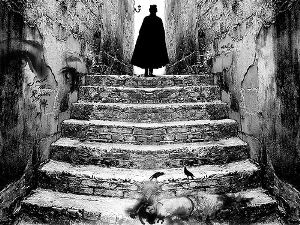Forensic Psychology Blog
(Photo Credit:
Ghostbones)
Happy New Year everyone.
When you teach and study forensic psychology, your interest in the topic stays with you all the time. For instance my holiday TV watching not only included the usual Christmas offerings (It's a wonderful life, Home Alone, Die Hard etc) but also Jack the Ripper: The First Serial Killer.
To be fair I came across this very interesting documentary by chance when flicking through the TV channels; but it's precisely the type of thing I would record and show my students as a way of stimulating discussion and debate. Jack the Ripper: The First Serial Killer was very useful in this respect as it touched on a number of concepts and issues that can be considered within a forensic, psychological and investigative context e.g. can criminal profiling reveal the behavioural make-up of an unknown offender?
Jack the Ripper: The First Serial Killer - Programme DetailsFor decades the crimes of Jack the Ripper have inspired both horror and intrigue. Theories abound as to the identity of the killer, but few are based on facts. This film follows Laura Richards, a behavioural analyst at New Scotland Yard's Violent Crime Directorate, as she re-opens the case of Jack the Ripper, the first modern serial killer. With the benefits of modern criminology and psychological analysis, and the aid of Britain's best detectives, Richards uses 21st century forensic techniques to understand a 19th century killer, dispelling the many myths that have grown up around the case and revealing the truth about Jack The Ripper, the first modern serial killer.
In the autumn of 1888 Jack the Ripper launched an unparalleled reign of terror onto the streets of London, leaving at least five women severely mutilated. To this day the case remains one of history's greatest mysteries. Drawing together a team who are all experts in their field, Richards sets aside all the suspects and focuses her attention on what the crimes have to say about the killer. Using geographic profiling, they uncover the location where he is likely to have lived and with modern techniques, reveal an accurate E-Fit portrait of the killer.
Richards builds a picture of a man who was perfectly sane, frighteningly normal, and yet capable of extraordinary cruelty. For the first time, we are able to understand the kind of person Jack the Ripper was; we can name the street where he probably lived; and we can see what he looked like; and we can explain, finally, why this killer eluded justice.
Jack the Ripper: The First Serial Killer
Related Material Going Beyond The Mo: Criminal Profiling, Jack The Ripper And Signature Behavior
Going Beyond The Mo: Criminal Profiling, Jack The Ripper And Signature BehaviorThis was the title of a forensic psychology blog post I did last year and I thought it would be worth re-publishing here.
The primary aim of criminal profiling is to reveal the behavioral make-up of an unknown offender. To understand how this can be achieved, this blog item draws upon Robert Keppel's analysis of the Jack the ripper murders in order to examine the concept of signature behavior and how this differs from the offender's Modus Operandi.
Modus Operandi I'm sure you've all watched a film or TV series where a detective at a crime scene asks what's the MO?. MO stands for Modus Operandi and it literally means way of working, and it's what an offender does in order to carry out a crime. For example, a burglar who always uses a glass cutter to gain access to a house is demonstrating an aspect of his or her MO or way of working. From an investigative point of view analysis of the offenders MO can be used to link cases at crime scenes, however, a major stumbling block is that an offenders MO (way of working) can change.
Consequently, according to criminal profilers you have to analyse behavior that transcends the MO. Innate behavior that is static and rigid; behavior that remains the same over time. This behavior relates to the things offenders are psychologically compelled to do over and above what it takes to commit the crime, and in the world of criminal profiling, this type of behaviour is known as signature behavior.
Signature behavior A very useful two part definition of offender signature is provided by Brent Turvey.
Signature Behaviors Signature behaviors are those acts committed by an offender that are not necessary to complete the offense. Their convergence can be used to suggest an offender's psychological or emotional needs (signature aspect). They are best understood as a reflection of the underlying personality, lifestyle, and developmental experiences of an offender
Signature Aspects The emotional or psychological themes or needs that an offender satisfies when they commit offense behaviors.
Robert Keppel has written widely on criminal profiling and signature behavior and analysis. In 2002 I was fortunate enough to hear him speak at a forensic science conference in Atlanta. Entitled: A signature analysis of the eight Whitechapel murders attributed to Jack the Ripper in 1888 Robert Keppel's presentation sought to explain the processes involved in linking murder cases through Modus Operandi and signature.
The reason I want to include it here is that I remember thinking at the time, and still do, that it provides an excellent way of showing how the MO and signature differ in terms of what they tell you about a particular crime. The following information is taken from Keppel's abstract in the conference proceedings.
Jack the Ripper's Modus Operandi He attacked white female prostitutes in their 40's in a cluster of victims within a short distance of each other. The first four victims Mary Nichols, Annie Chapman, Elizabeth Stride and Catherine Eddowes were killed and found outdoors in the Whitechapel area; then he changed his MO by killing and leaving the fifth victim Mary Kelly, indoors. By choosing to murder Kelly indoors, the killer demonstrated that he was an experienced night time cat burglar and stalker, as he attacked all his victims in the early morning hours when dawn was approaching
Jack the Ripper's signature Remember this relates to what he did over and above what was necessary to commit the crime, it transcends the MO Each victim was posed in a sexually degrading position, intentionally left that way so the discovery of the bodies would startle the people who found them. They were not concealed or hidden away, but placed in locations where they would be easily discovered. The placing of the victims on their back, grotesquely laid out with their throats cut and viscera exposed or missing, reflect the cruel reality of the killer, his total mastery over their bodies. The pleasure for the killer was demonstrating each victims vulnerability.
Incidentally Keppel does not believe that all the murders attributed to Jack the ripper where in fact carried out by him. He claims that in the case of three of his alleged victims there were fundamental differences in the signature of the crimes.
However, there is no doubt that like his fellow writers on the topic Keppel firmly believes that signature behaviour represents a real and intrinsic part of the offender's personality.
"Hidden among the evidence, often gleaned from the marks and wounds on the victim's body these signatures are the only ways the killer truly expresses himself." (Keppel & Burns).
Further Information From The Forensic Psychology websiteGeographic ProfilingCriminal Profiling: First Documented UseCriminal Profiling: The FBI Legacy
Please share this Forensic Psychology Blog Post with others by adding it to your social bookmarks.

How you doin? Let people know with our unique personality trait t-shirts and gifts. Whatever your mood, express it with style with our innovative design range. Or why not show your family and friends that you know what makes them tick; psychological profiling has never been so cool and a new forensic range has just been added.
Any profit made from the Personality Trait Cafepress store will be put towards the hosting and development costs associated with the All About
forensic psychology and All About
forensic science websites.
Click Here to visit the Personality Trait CafePress Store.



 www.all-about-forensic-psychology.comA Free & Comprehensive Guide to The World of Forensic PsychologyJack the Ripper: The First Serial Killer
www.all-about-forensic-psychology.comA Free & Comprehensive Guide to The World of Forensic PsychologyJack the Ripper: The First Serial Killer










